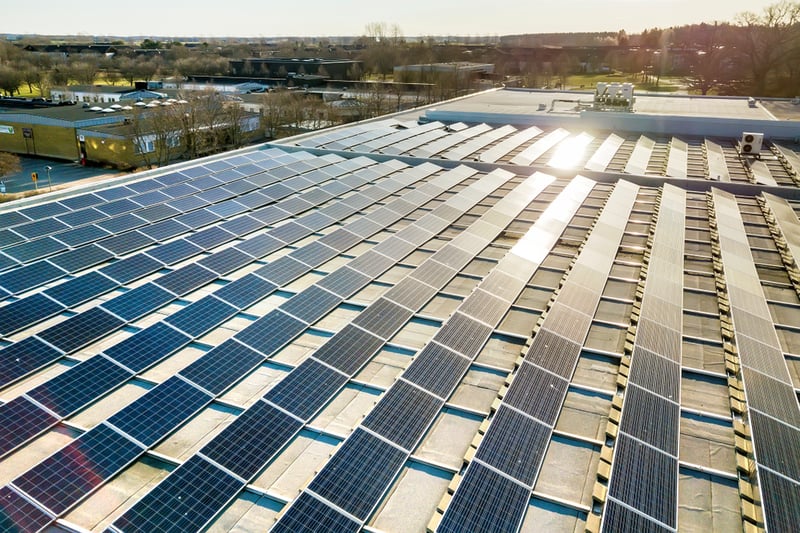What Interest Rate Is Suitable for a Commercial Solar Loan?

Commercial solar systems can achieve a payback period of less than six years under favorable site conditions. However, the payback period only applies for users who pay for solar installations with their own capital. Many building owners decide to finance their solar energy systems with loans, and then use energy savings to cover loan payments.
If the electricity savings achieved by a solar array are higher than loan payments from year one, you reach positive cash flow right away. The out-of-pocket cost becomes zero, and the payback period is also reduced to zero as a result. However, this strategy only works if you can find a loan with a suitable interest rate.
Get a professional solar PV system design. Qualify for financial incentives and low-interest green loans.
In this article, we will discuss how you can decide if a loan is suitable for a commercial solar installation. Since project conditions and electricity prices vary by location, the interest rate at which loan financing is viable also changes. For this reason, we cannot calculate a specific value that will work for all solar installations.
Step 1 - Know Your Monthly Savings

To determine if a commercial solar installation can pay off a loan, first we must know the monthly savings, considering that there are also maintenance and insurance costs. Assuming you have a good site for solar panels in southern regions of NY state, each kilowatt-peak of installed capacity can yield around 1,400 kWh/year.
- Based on this figure, a 300-kW solar array would generate around 420,000 kWh/year.
- At 20 cents/kWh, this is equivalent to $84,000/year in savings, or $7,000/month.
Assuming an installed price of $2/watt, the entire system would cost $600,000. Annual insurance costs for solar PV systems are typically around 0.50% of CAPEX, while maintenance is typically around 0.70% of CAPEX. These expenses are much lower than the savings:
- Insurance = 0.50% of CAPEX = $3,000/year ($250/month)
- Maintenance = 0.70% of CAPEX = $4,200/year ($350/month)
Subtracting insurance and maintenance costs, you still have around $6,400 in monthly energy savings. Any loan with monthly payments below this value is viable, since the project pays it off completely at zero net cost for you.
Step 2 - Subtract Any Rebates Available

Since this commercial solar system is located in NY state, it qualifies for the NYSERDA incentive. Program funding is currently depleted in Long Island, but solar installation in the Con Edison and upstate NY areas both qualify. A 300-kW commercial solar array would get $1.00/watt in the Con Edison territory, and $0.35/watt in the upstate NY region.
Assuming this project is located in NYC (Con Edison), it gets an incentive of $300,000 and the net price is effectively halved. You only need a loan for $300,000, and not the full value of $600,000. Also consider the tax benefits:
- Solar Investment Tax Credit: 30% federal tax credit on your next declaration
- Accelerated Depreciation (MACRS): You write off 85% of the asset value in only five years, even when the service life is 25 years or more.
Since tax benefits are claimed over time, you still need to get a loan for $300,000 to cover 100% of upfront costs.
Step 3 - Compare Interest Rates and Loan Payments
In Step 1 we determined that the 300-kW solar array yields $6,400 in monthly savings, after subtracting maintenance and insurance costs. This is the number to keep in mind when you compare financing options.
The following table estimates the monthly payment if you get a $300,000 loan with a 10-year term, assuming monthly payments and several interest rates. As you can see, the net monthly savings decrease as the interest rate increases, since a larger portion of your savings is used for debt service:
|
Interest Rate |
Monthly Payment |
Net Cash Flow |
|
6% |
-$3,330.62 |
$3,069.38 |
|
8% |
-$3,639.83 |
$2,760.17 |
|
10% |
-$3,964.52 |
$2,435.48 |
|
12% |
-$4,304.13 |
$2,095.87 |
|
15% |
-$4,840.05 |
$1,559.95 |
|
20% |
-$5,797.67 |
$602.33 |
|
25% |
-$6,824.79 |
-$424.79 |
Since this project saves electricity at 20 cents/kWh while getting a 50% rebate, it remains viable at high interest rates. We can assume another scenario in the upstate NY region, where the rebate is decreased to $0.35/watt. In this case the total rebate amount drops from $300,000 to $105,000, and the upfront cost increases to $495,000 (this is the loan amount you need).
|
Interest Rate |
Monthly Payment |
Net Cash Flow |
|
6% |
-$5,495.51 |
$904.49 |
|
8% |
-$6,005.72 |
$394.28 |
|
10% |
-$6,541.46 |
-$141.46 |
|
12% |
-$7,101.81 |
-$701.81 |
|
15% |
-$7,986.08 |
-$1,586.08 |
|
20% |
-$9,566.16 |
-$3,166.16 |
|
25% |
-$11,260.90 |
-$4,860.90 |
You need an interest rate below 10% to make loan financing viable in this specific example. This happens because the upfront cost is higher, and monthly payments also increase as a result.
In the first example, loan financing remains viable at interest rates as high as 20%, since upfront costs are greatly reduced by the $1.00/W incentive. However, you will still want to find the lowest possible interest rate to maximize monthly savings.

Michael Tobias
Michael Tobias, the Founding Principal of NY Engineers, currently leads a team of 150+ MEP/FP engineers and has led over 4,000 projects in the US
Join 15,000+ Fellow Architects and Contractors
Get expert engineering tips straight to your inbox. Subscribe to the NY Engineers Blog below.

